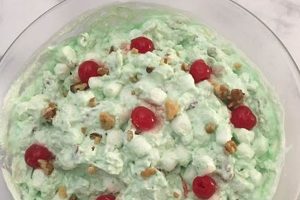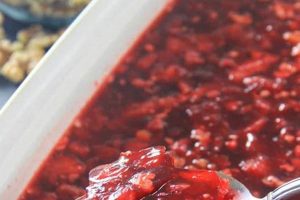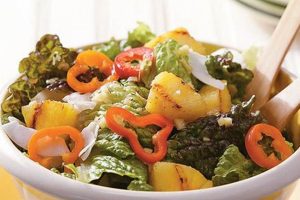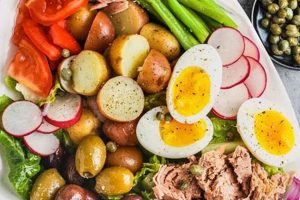A top-tier preparation of this grain dish involves a balanced interplay of flavorful ingredients and a perfectly cooked base. For example, a well-regarded combination might include fluffy quinoa, crisp vegetables like cucumber and bell peppers, fresh herbs such as parsley and mint, and a vibrant lemon-tahini dressing.
A thoughtfully constructed grain salad offers a nutritious and satisfying meal. Quinoa, a complete protein source, provides essential amino acids. Combined with fresh produce and a flavorful dressing, these salads offer a variety of vitamins, minerals, and antioxidants. Furthermore, the adaptability of quinoa allows for endless variations, catering to diverse palates and dietary needs. Historically, quinoa has been a staple food in the Andean region for centuries, valued for its nutritional value and versatility. Its recent surge in popularity reflects a growing appreciation for healthy and flavorful cuisine worldwide.
The following sections will explore various aspects of crafting an exceptional quinoa salad, from selecting the appropriate ingredients to mastering cooking techniques and exploring diverse flavor profiles.
Tips for a Superior Quinoa Salad
Creating a truly exceptional dish requires attention to detail and an understanding of the interplay of flavors and textures. These guidelines offer valuable insights into elevating a simple quinoa salad to a culinary masterpiece.
Tip 1: Rinse the quinoa thoroughly. This removes the naturally occurring bitter coating (saponins) for a more palatable final product. Place the quinoa in a fine-mesh sieve and rinse under cold water until the water runs clear.
Tip 2: Toast the quinoa before cooking. Toasting enhances the nutty flavor of the quinoa. Heat a dry skillet over medium heat and toast the quinoa for a few minutes, stirring constantly, until fragrant.
Tip 3: Cook the quinoa properly. Use a 2:1 ratio of water to quinoa. Bring the water to a boil, add the quinoa, reduce heat to low, cover, and simmer for 15-20 minutes, or until all the water is absorbed.
Tip 4: Fluff the quinoa with a fork. Once cooked, fluff the quinoa with a fork to separate the grains and prevent clumping. This also allows the quinoa to cool more quickly and evenly.
Tip 5: Incorporate a variety of textures. Combine cooked quinoa with crisp vegetables, such as chopped cucumbers, bell peppers, or carrots, for textural contrast.
Tip 6: Add fresh herbs. Fresh herbs, such as parsley, mint, or cilantro, add brightness and depth of flavor. Chop them finely and add them just before serving.
Tip 7: Choose a vibrant dressing. A well-balanced dressing complements the quinoa and other ingredients. A lemon-tahini dressing, a simple vinaigrette, or a herbed yogurt dressing can elevate the overall flavor profile.
Tip 8: Allow the flavors to meld. For optimal flavor development, allow the salad to chill in the refrigerator for at least 30 minutes before serving. This allows the ingredients to marry and the flavors to deepen.
By following these suggestions, one can achieve a well-balanced and flavorful result, maximizing the nutritional and culinary potential of this versatile grain.
The following section will conclude with a summary of key considerations for crafting the perfect quinoa salad.
1. Flavor Balance
Flavor balance is paramount in achieving a superlative quinoa salad. A truly exceptional dish harmonizes contrasting yet complementary taste profiles, creating a nuanced and satisfying culinary experience. This balance prevents any single flavor from dominating, allowing the individual components to shine while contributing to a cohesive whole. Consider the interplay of sweet and savory elements: the natural sweetness of roasted vegetables like sweet potatoes or butternut squash can be beautifully offset by the savory notes of toasted nuts or crumbled feta cheese. Similarly, the bright acidity of a lemon vinaigrette cuts through the richness of avocado or a creamy dressing, creating a refreshing counterpoint.
The principle of flavor balance extends beyond basic taste profiles to encompass other sensory elements. The earthiness of mushrooms can be balanced by the herbaceous brightness of parsley or cilantro. A touch of spice from chopped jalapeos or a pinch of red pepper flakes adds complexity and excitement without overwhelming the palate. Textural contrasts also play a role in perceived flavor balance. The soft, fluffy quinoa provides a neutral backdrop for the crispness of raw vegetables like cucumber or bell pepper, the creaminess of avocado, and the satisfying crunch of toasted nuts or seeds. Each element contributes to a multi-dimensional sensory experience that elevates the dish beyond a simple combination of ingredients.
Mastering flavor balance is essential for creating a quinoa salad that transcends the ordinary. It requires careful consideration of ingredient pairings, an understanding of contrasting taste profiles, and a willingness to experiment with different flavor combinations. By achieving this delicate equilibrium, one unlocks the full potential of this versatile grain and creates a dish that is both nutritious and deeply satisfying.
2. Texture Variety
Textural variety is a critical component of a superior quinoa salad. A successful recipe moves beyond the inherent fluffiness of cooked quinoa, incorporating a range of contrasting textures to create a more dynamic and satisfying culinary experience. This interplay of textures elevates the dish from simple sustenance to a more complex and engaging meal. Consider the addition of crisp elements: chopped cucumbers, bell peppers, or shredded carrots introduce a refreshing crunch that contrasts beautifully with the soft quinoa. Toasted nuts or seeds, such as almonds, walnuts, or pumpkin seeds, contribute a satisfying bite and nutty flavor. These contrasting textures prevent the salad from becoming monotonous, stimulating the palate and enhancing overall enjoyment.
Further textural depth can be achieved through the incorporation of creamy components. Avocado, crumbled feta cheese, or a dollop of hummus introduce a luxurious smoothness that complements the other textures. These additions not only enhance the sensory experience but also contribute to the nutritional profile of the salad. For example, avocado provides healthy fats and a creamy texture, while feta cheese offers a salty, tangy flavor and a crumbly texture. Even the dressing can contribute to textural complexity. A thicker dressing, such as a tahini-based dressing, clings to the quinoa and other ingredients, creating a more cohesive and satisfying mouthfeel, while a lighter vinaigrette offers a contrasting sharpness.
The strategic combination of textures transforms a basic quinoa salad into a culinary masterpiece. It demonstrates an attention to detail and an understanding of how different textures interact to create a more complete and enjoyable eating experience. This principle of textural variety is crucial for achieving a truly exceptional dish, demonstrating a mastery of culinary technique and an appreciation for the nuanced interplay of sensory elements.
3. Ingredient Quality
Ingredient quality directly impacts the overall caliber of a quinoa salad. Superior ingredients contribute not only to enhanced flavor but also to a more vibrant appearance, improved texture, and increased nutritional value. The inherent flavor of quinoa, being relatively neutral, allows it to act as a canvas for the other ingredients, highlighting their individual characteristics. Thus, the use of fresh, high-quality produce is essential for a truly exceptional outcome. For example, opting for ripe, in-season tomatoes bursting with flavor rather than bland, out-of-season alternatives significantly elevates the overall taste and freshness of the salad. Similarly, utilizing fragrant, freshly chopped herbs, as opposed to dried or wilted ones, amplifies the aromatic complexity and visual appeal.
Furthermore, ingredient quality extends beyond produce. Selecting premium oils, such as extra virgin olive oil with a robust flavor profile, enhances the richness and complexity of the dressing. Likewise, utilizing freshly squeezed lemon juice instead of bottled varieties offers a brighter, more vibrant acidity. Even the choice of quinoa itself plays a role; organic quinoa, while often more expensive, may offer a cleaner flavor and superior nutritional content. Attention to detail in sourcing and selecting each ingredient contributes to the creation of a cohesive and harmonious dish, where each component plays a vital role in elevating the overall experience. Investing in high-quality ingredients not only maximizes flavor but also demonstrates a commitment to culinary excellence, transforming a simple salad into a memorable culinary creation.
Ultimately, a commitment to ingredient quality distinguishes an ordinary quinoa salad from an exceptional one. This dedication reflects an understanding that the final product is only as good as the sum of its parts. By prioritizing quality at every stage, from sourcing ingredients to careful preparation, one ensures a dish that is not only flavorful and visually appealing but also nutritionally dense and deeply satisfying. The pursuit of superior ingredients is therefore an essential step towards crafting a quinoa salad that truly deserves the title of “best.”
4. Proper Quinoa Cooking
Proper quinoa cooking forms the cornerstone of an exceptional quinoa salad. The texture and flavor of the cooked quinoa significantly influence the final dish’s overall quality. Undercooked quinoa results in a crunchy, unpleasant texture, while overcooked quinoa becomes mushy and loses its distinct character. Mastering the cooking process ensures a light, fluffy texture that serves as the perfect foundation for a vibrant and flavorful salad.
- The Rinse: Removing Saponins
Rinsing quinoa before cooking is crucial for removing saponins, naturally occurring compounds that contribute a bitter flavor. Thoroughly rinsing under cold water until the water runs clear eliminates this bitterness, resulting in a more palatable final product. Neglecting this step can negatively impact the overall flavor profile of the salad, overpowering the other delicate ingredients.
- The Toast: Enhancing Nutty Flavors
Toasting quinoa before cooking enhances its inherent nutty flavor. Heating the dry grains in a skillet over medium heat for a few minutes, while stirring constantly, deepens their complexity and aroma. This step, while optional, contributes a subtle yet noticeable depth of flavor that complements the other ingredients in the salad.
- The Cook: Achieving Optimal Texture
Cooking quinoa correctly is paramount for achieving the desired light and fluffy texture. The standard ratio of two parts water to one part quinoa ensures proper hydration and even cooking. Bringing the water to a boil, adding the quinoa, reducing heat to low, covering, and simmering for 15-20 minutes, or until all the water is absorbed, yields perfectly cooked grains. Overcooking or undercooking at this stage can compromise the texture and overall enjoyment of the salad.
- The Fluff: Separating and Cooling
Fluffing the cooked quinoa with a fork after it has rested for a few minutes separates the grains and prevents clumping. This also facilitates even cooling, which is essential for preventing the quinoa from becoming mushy and for ensuring that it readily absorbs the flavors of the dressing and other ingredients. This step contributes to the desired light and airy texture that characterizes a well-made quinoa salad.
These facets of proper quinoa cooking contribute significantly to the creation of a truly exceptional salad. A properly cooked base provides a neutral canvas that showcases the other components’ flavors and textures, while its light and fluffy consistency ensures a pleasant mouthfeel. Mastering these techniques is essential for achieving a dish that is both delicious and visually appealing, reflecting a commitment to culinary excellence and an appreciation for the nuanced interplay of ingredients and techniques.
5. Complementary Dressing
A complementary dressing is integral to a best quinoa salad recipe. The dressing’s role transcends merely adding moisture; it acts as a unifying element, harmonizing the diverse flavors and textures within the salad. A thoughtfully chosen dressing enhances the inherent qualities of the quinoa and other ingredients without overpowering them. The interplay between the dressing and the other components is crucial; a bland dressing fails to elevate the dish, while an overly assertive one masks the delicate flavors of the other ingredients. For instance, a bright, citrus-based vinaigrette complements the nutty flavor of quinoa and the freshness of vegetables, while a creamy tahini dressing provides a richer counterpoint to roasted vegetables and herbs.
The effectiveness of a complementary dressing lies in its ability to balance and enhance the existing flavors. A lemon-herb vinaigrette, for example, adds a refreshing acidity that cuts through the richness of avocado or feta cheese, while simultaneously highlighting the herbaceous notes of parsley or mint. A well-balanced dressing considers the overall flavor profile of the salad. A salad featuring roasted sweet potatoes and toasted pecans benefits from a maple-balsamic vinaigrette, which complements the sweetness of the potatoes and the nuttiness of the pecans. Conversely, a Mediterranean-inspired quinoa salad with cucumbers, tomatoes, and olives harmonizes well with a lighter, lemon-oregano dressing. Understanding these flavor pairings allows for the creation of a cohesive and well-rounded dish where each element contributes to the overall sensory experience.
Achieving a truly exceptional quinoa salad requires careful consideration of the dressing’s role in unifying and elevating the other components. The dressing should complement, not compete with, the existing flavors and textures, creating a balanced and harmonious culinary experience. This principle of complementarity is essential for achieving a dish that not only tastes delicious but also showcases the versatility and potential of quinoa as a culinary staple. Successful flavor pairings and textural considerations in dressing selection distinguish a merely adequate quinoa salad from a truly outstanding one.
6. Fresh Herbs
Fresh herbs constitute an indispensable element in elevating a quinoa salad from satisfactory to exceptional. Their inclusion introduces a vibrancy and depth of flavor often absent in salads relying solely on dried herbs or spices. Fresh herbs contribute more than just flavor; they impart brightness, complexity, and an aromatic dimension that significantly enhances the sensory experience. This impact stems from the volatile oils present in fresh herbs, which dissipate quickly upon drying. Consider the difference between freshly chopped cilantro and its dried counterpart: the fresh cilantro offers a bright, citrusy aroma and flavor, while the dried version often tastes dull and earthy. This distinction underscores the crucial role fresh herbs play in achieving a truly superior quinoa salad.
Specific herb choices can further enhance the overall flavor profile, creating targeted culinary experiences. For example, a Mediterranean-inspired quinoa salad benefits from the addition of fresh parsley, mint, and oregano, which complement the flavors of olives, feta cheese, and lemon vinaigrette. Alternatively, a Southwestern-inspired salad featuring corn, black beans, and a lime dressing gains complexity from the inclusion of cilantro and chives. The judicious selection of fresh herbs allows for customization and nuanced flavor development, transforming a simple quinoa salad into a culinary expression tailored to specific preferences. Beyond flavor, fresh herbs contribute to the visual appeal of the salad. Their vibrant green hues add a pop of color, making the dish more enticing and appetizing.
In conclusion, the integration of fresh herbs represents a pivotal step towards crafting a truly exceptional quinoa salad. Their aromatic complexity, vibrant flavors, and visual appeal significantly elevate the sensory experience, distinguishing a superior salad from a merely adequate one. Understanding the nuanced interplay between fresh herbs and other salad components allows for the creation of balanced, flavorful, and visually appealing dishes that showcase the versatility and culinary potential of quinoa. The careful selection and application of fresh herbs thus constitute a hallmark of culinary expertise in the realm of quinoa salad preparation. Disregarding this element can lead to a bland and uninspired result, underscoring the essential role fresh herbs play in achieving culinary excellence.
7. Visual Appeal
Visual appeal plays a significant role in the perception and enjoyment of a quinoa salad. A visually appealing presentation elevates the dining experience, stimulating appetite and enhancing perceived flavor. While taste remains paramount, an aesthetically pleasing salad encourages engagement and appreciation. The visual composition contributes to the overall impression of quality and care in preparation, transforming a simple meal into a more considered culinary creation. This connection between visual appeal and perceived quality underscores its importance in crafting a truly exceptional quinoa salad.
- Color Palette
A vibrant and varied color palette significantly enhances visual appeal. A monochromatic salad, while potentially flavorful, can appear uninspired. Incorporating a range of colors from diverse ingredients deep green spinach, bright red bell peppers, sunny yellow corn, and earthy brown mushrooms creates visual interest and suggests a variety of nutrients. Strategic placement of ingredients further amplifies this effect, transforming the salad into an edible work of art. This colorful arrangement not only stimulates the appetite but also suggests a balanced and nutritious meal.
- Textural Contrast
Visual texture contributes as much to appeal as tactile texture. A salad composed solely of finely chopped ingredients lacks visual dynamism. Incorporating ingredients with varied shapes and sizes, such as whole cherry tomatoes, crumbled feta cheese, and slivered almonds, creates visual intrigue. This contrast prevents visual monotony, adding depth and complexity to the presentation. The interplay of light and shadow on these varied textures further enhances the visual appeal, creating a more engaging and appetizing dish.
- Plating and Presentation
Plating and presentation elevate the visual experience. Simply dumping the salad into a bowl fails to capitalize on its visual potential. Consider the impact of a thoughtfully arranged salad: quinoa mounded in the center, surrounded by artfully placed vegetables, garnished with a sprinkle of fresh herbs and a drizzle of dressing. Such attention to detail elevates the perceived value of the dish, transforming it from a casual meal into a more refined culinary experience. The choice of serving vessel also contributes; a shallow bowl or platter showcases the salad’s components more effectively than a deep bowl where ingredients become hidden.
- Garnishes and Finishing Touches
Garnishes and finishing touches provide the final flourish, completing the visual narrative. A sprinkle of toasted sesame seeds, a scattering of microgreens, or a drizzle of high-quality olive oil adds a touch of elegance and elevates the perceived quality. These small details demonstrate care and attention, transforming a simple quinoa salad into a more sophisticated and visually appealing dish. Garnishes should complement the existing flavors and colors, adding a final layer of visual interest without overpowering the overall composition.
These elements of visual appeal contribute significantly to the overall enjoyment of a quinoa salad. A visually appealing presentation enhances the dining experience, making the salad more enticing and appetizing. While flavor remains paramount, visual appeal plays a crucial role in perception and appreciation. By considering these visual aspects, one can elevate a simple quinoa salad to a culinary creation that is both delicious and aesthetically pleasing, truly embodying the qualities of a “best” recipe.
Frequently Asked Questions
This section addresses common inquiries regarding the preparation and enjoyment of superior quinoa salads, offering practical guidance and clarifying potential misconceptions.
Question 1: How can one prevent quinoa from becoming mushy?
Mushiness results from overcooking or insufficient rinsing. Adhering to the recommended 2:1 water-to-quinoa ratio and cooking time prevents overcooking. Thoroughly rinsing the quinoa before cooking removes excess starch, further contributing to a desirable fluffy texture.
Question 2: What are suitable substitutes for common quinoa salad ingredients?
Ingredient substitutions offer flexibility for dietary restrictions and preferences. Quinoa itself can be substituted with couscous or farro. Specific vegetables can be interchanged based on availability and preference. Dietary restrictions can be accommodated by substituting dairy-based dressings with plant-based alternatives.
Question 3: How long can quinoa salad be stored?
Properly stored quinoa salad typically lasts up to three days in an airtight container refrigerated. However, the addition of certain ingredients, such as avocado, may shorten this timeframe due to faster spoilage. Visual inspection and smell serve as reliable indicators of freshness.
Question 4: Can quinoa salad be served warm?
While typically served cold, quinoa salad can be enjoyed warm. Freshly cooked quinoa can be combined with warm roasted vegetables and a warm dressing for a comforting variation. Certain ingredients, such as delicate leafy greens, may be better suited for cold preparations.
Question 5: How can one enhance the flavor of quinoa salad?
Flavor enhancement relies on balancing complementary ingredients and seasonings. Toasted nuts, dried fruits, and flavorful cheeses contribute depth and complexity. Freshly squeezed citrus juice or zest adds brightness. High-quality oils and vinegars form the foundation of flavorful dressings, further elevating the overall taste experience.
Question 6: What are the nutritional benefits of quinoa salad?
Quinoa, a complete protein and excellent source of fiber, forms a nutritionally dense base. Incorporating a variety of vegetables increases vitamin and mineral intake. Healthy fats from sources like avocado or nuts further contribute to nutritional value. Overall, quinoa salad offers a balanced and nutritious meal option.
Careful attention to these considerations ensures a successful and satisfying culinary experience.
This concludes the frequently asked questions section. The following segment provides recipe ideas for various quinoa salad variations.
Best Quinoa Salad Recipe
Achieving a truly exceptional quinoa salad involves a multifaceted approach. From the meticulous selection of high-quality ingredients to the precise execution of cooking techniques and the artful balance of flavors and textures, each step contributes to the final product’s overall excellence. Properly cooked quinoa, free from bitterness and boasting a light, fluffy texture, forms the essential foundation. A carefully crafted dressing, complementing rather than overpowering the other components, unifies the dish. The incorporation of fresh, vibrant herbs adds depth and complexity, while a diverse array of colorful vegetables and textural elements creates a visually appealing and nutritionally balanced meal. Attention to these details distinguishes a superior quinoa salad from a mediocre one.
Culinary exploration yields boundless possibilities for variation and personalization within the realm of quinoa salad creation. The adaptability of this versatile grain allows for a spectrum of flavor profiles, accommodating diverse palates and dietary preferences. Continued experimentation with ingredients, textures, and dressings promises further refinement and innovation in the pursuit of the ultimate quinoa salad experience. This pursuit represents a commitment to culinary excellence, transforming a simple dish into a celebration of flavor, texture, and visual artistry.






